Classification Requirements for Chemical Maritime – A Guide for International Sea Freight
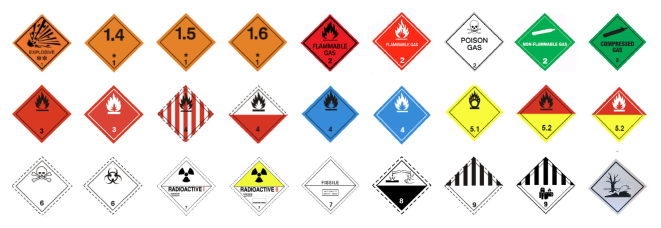 As a freight forwarding company, chemical exports are a crucial part of our international sea freight operations. Chemicals come in various forms, including hazardous and non-hazardous goods, each with specific shipping and labeling requirements. This article provides a comprehensive overview of chemical export classifications, common product names, special considerations, and labeling standards to help clients better understand key aspects of chemical shipping.
As a freight forwarding company, chemical exports are a crucial part of our international sea freight operations. Chemicals come in various forms, including hazardous and non-hazardous goods, each with specific shipping and labeling requirements. This article provides a comprehensive overview of chemical export classifications, common product names, special considerations, and labeling standards to help clients better understand key aspects of chemical shipping.
I. Hazardous Goods Classification (Classes 1-9) and Labeling Requirements
According to the International Maritime Dangerous Goods (IMDG) Code by the International Maritime Organization (IMO), hazardous goods are divided into 9 classes, with some further subdivided. Below is a detailed breakdown of each class, along with common chemical examples:
1. Class 1: Explosives
1.1: Substances with mass explosion hazard (e.g., TNT, nitroglycerin).
1.2: Substances with projection hazard but no mass explosion (e.g., certain ammunition).
1.3: Substances with fire hazard and minor blast/projection risk (e.g., fireworks).
1.4: Substances with no significant hazard (e.g., signal flares).
1.5: Very insensitive explosives (e.g., ammonium nitrate fuel oil).
1.6: Extremely insensitive articles with no mass explosion hazard.
Labeling: Orange background with black symbol, explosion pictogram, and division number (e.g., 1.1, 1.2).
2. Class 2: Gases
2.1 (Flammable gases): Propane, hydrogen, lighter fuel.
2.2 (Non-flammable, non-toxic gases): Oxygen, carbon dioxide, nitrogen.
2.3 (Toxic gases): Chlorine, anhydrous ammonia.
Labeling:
2.1: Red background (flame symbol).
2.2: Green background (gas cylinder).
2.3: White background (skull and crossbones).
3. Class 3: Flammable Liquids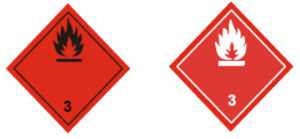
Common examples: Gasoline, ethanol, acetone, paint, resin solvents.
Criteria: Flash point ≤ 60°C (e.g., ethanol flash point: 12°C).
Labeling: Red background with black flame symbol.
4. Class 4: Flammable Solids
4.1 (Flammable solids): Sulfur, matches, nitrocellulose.
4.2 (Spontaneously combustible): Yellow phosphorus, fish meal (moisture-sensitive).
4.3 (Dangerous when wet): Sodium metal, calcium carbide.
Labeling:
4.1: Red and white stripes (flame).
4.2: Upper white, lower red (flame).
4.3: Blue background (flame).
5. Class 5: Oxidizing Substances & Organic Peroxides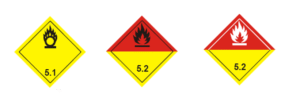
5.1 (Oxidizers): Potassium permanganate, hydrogen peroxide (>8%).
5.2 (Organic peroxides): Benzoyl peroxide (requires temperature control).
Labeling:
5.1: Yellow background (flame over circle).
5.2: Red and yellow halves.
6. Class 6: Toxic & Infectious Substances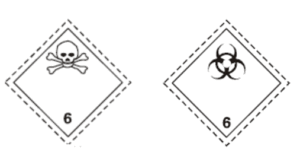
6.1 (Toxic substances): Pesticides (e.g., dichlorvos), cyanides.
6.2 (Infectious substances): Medical waste, virus samples.
Labeling:
6.1: White background (skull and crossbones).
6.2: White background (biohazard symbol).
7. Class 7: Radioactive Materials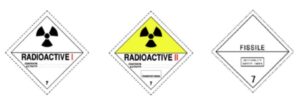
Common examples: Uranium, medical radioactive equipment.
Classification: Based on radiation levels (I, II, III).
Labeling: White background with black and yellow stripes, radiation symbol, and class (e.g., “II”).
8. Class 8: Corrosives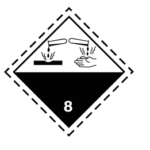
Common examples: Sulfuric acid, hydrochloric acid, sodium hydroxide, battery fluid.
Labeling: Upper white, lower black (liquid dripping onto metal/hand).
9. Class 9: Miscellaneous Dangerous Goods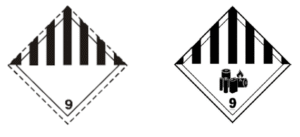
Includes: Lithium batteries, asbestos, dry ice, marine pollutants (e.g., certain pesticides).
Labeling: White background with black stripes (7 vertical lines).
II. Common Non-Hazardous Chemicals
General chemicals: Plastic pellets, mineral oil (non-flammable), food additives (e.g., citric acid), dyes.
Industrial materials: Soda ash, silica gel, sodium chloride (table salt).
III. Special Considerations for Chemical Shipping
Marine Pollutants: Some chemicals (e.g., pesticides, heavy metal compounds) require “Marine Pollutant” labeling.
Temperature Control: Certain organic peroxides (Class 5.2) need refrigerated transport.
Packaging Standards: UN-certified packaging (e.g., steel drums, IBC totes).
Documentation: MSDS (Material Safety Data Sheet), Dangerous Goods Declaration, packing certificate.
IV. Hazardous Goods Labeling Summary
Size: Minimum 10cm × 10cm (larger for containers).
Placement: On two opposite sides of the package and clearly visible on containers.
Content: UN number, proper shipping name, hazard class, emergency contact.
Conclusion
Shipping chemicals involves complex classifications and compliance requirements. Shippers must provide MSDS in advance and confirm transport methods. As a professional freight forwarder, we assist with dangerous goods declarations, booking, and container loading to ensure safe and compliant shipments. For further inquiries, feel free to contact us!